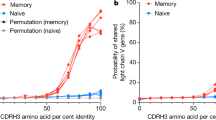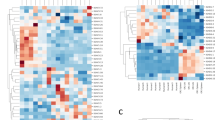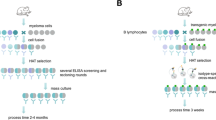Abstract
THE mechanism by which the immune system produces an apparently limitless array of antibodies in response to a variety of antigenic stimuli remains an unresolved biological question. Primary structural analysis has shown that immunoglobulin heavy (H) and light (L) chains have both variable (V) and constant (C) regions of amino acid sequence. Within the VH and VL region sequences there are areas of hypervariability which are thought to be associated with the antibody combining site. It is the amino acid substitutions within certain of these hypervariable areas that result in the multiplicity of antibody specificities (sites) expressed in nature. It seems clear that separate genes code for the V and C regions of H and L chains and that integration of V- and C-region genes occurs at the DNA level1. One can account for antibody isotypic diversity by postulating a limited number of C-region genes which are transmitted from generation to generation in the germ line. The difficulty arises in the attempt to account for the apparent large numbers of V-region genes required to explain antibody combining site diversity. V-gene counting has been accomplished by RNA–DNA hybridisation2–4. Evidence from these studies has not definitely demonstrated whether the capacity to generate large numbers of combining sites exclusively arises by either the inheritance of a complete set of VH and VL genes in the germ line or by somatic mutation. The repeated occurrence of V-gene products has, however, been indicated by sequence analysis of myeloma proteins5–7, isoelectric focusing8–10, and idiotypic analysis11–13.
This is a preview of subscription content, access via your institution
Access options
Subscribe to this journal
Receive 51 print issues and online access
$199.00 per year
only $3.90 per issue
Buy this article
- Purchase on Springer Link
- Instant access to full article PDF
Prices may be subject to local taxes which are calculated during checkout
Similar content being viewed by others
References
Milstein, C., and Munro, A. J., Defense and Recognition, Biochemistry Series One (edit. by Porter, R. R.), 10, 199–228 (University Park Press, Baltimore, 1973).
Premkumar, E., Shoyab, M., and Williamson, A. R., Proc. natn. Acad. Sci. U.S.A., 71, 99–103 (1974).
Leder, P., Honjo, T., Packman, S., Swan, D., Nav, M., and Norman, B., in The Immune System Genes, Receptors and Signals (edit. by Sercarz, E. E., Williamson, A. R., and Fox, C. F.), 299–317 (Academic, New York, 1974).
Tonegawa, S., Steinberg, C., Dube, S., and Bernardini, A., Proc. natn. Acad. Sci. U.S.A., 71, 4027–4031 (1974).
Weigert, M. G., Cesari, I. M., Yonkovich, S. J., and Cohn, M., Nature, 228, 1045–1047 (1970).
Cohn, M., Blomberg, B., Geckeler, W., Raschke, W., Riblet, R., and Weigert, M., The Immune System, Genes, Receptors and Signals (edit. by Sercarz, E. E., Williamson, A. R., and Fox, C. F.), 99–117 (Academic, New York, 1974).
Barstad, P., Farnsworth, V., Weigert, M., Cohn, M., and Hood, L., Proc. natn. Acad. Sci. U.S.A., 71, 4096–4100 (1974).
Kreth, H. W., and Williamson, A. R., Eur. J. Immun., 3, 141–147 (1973).
Schlossman, S. F., and Williamson, A. R., Genetic Control of Immune Responsiveness (edit. by McDevitt, H. O., and Landy, M.), 54–60 (Academic, New York, 1972).
Pink, J. R. L., and Askonas, B. A., Eur. J. Immun., 4, 426–430 (1974).
Eichmann, K., Eur. J. Immun., 2, 301–307 (1972).
Kindt, T. J., Seide, R. K., Bokisch, V. A., and Krause, R. M., J. exp. Med., 138, 522–536 (1973).
Claflin, J. L., and Davie, J. M., J. exp. Med., 140, 673–686 (1974).
Hood, L., and Talmage, D. W., Science, 168, 325–334 (1970).
Wigzell, H., Scand. J. Immun., 2, 199–206 (1973).
Hood, L., Barstad, P., Loh, E., and Nottenburg, C., The Immune System, Genes, Receptors and Signals (edit. by Sercarz, E. E., Williamson, A. R., and Fox, C. F.), 119–139 (Academic Press, New York, 1974).
Capra, J. D., and Kehoe, J. M., Proc. natn. Acad. Sci. U.S.A., 71, 4032–4036 (1974).
Montgomery, P. C., Rockey, J. H., and Williamson, A. R., Proc. natn. Acad. Sci. U.S.A., 69, 228–232 (1972).
Montgomery, P. C., Rockey, J. H., Kahn, R. L., and Skandera, C. A., J. Immun. (in the press).
Klinman, N. R., J. Immun., 106, 1330–1337 (1971).
Ghose, A. C., and Karush, F., J. Immun., 113, 162–172 (1974).
Huser, H., Haimovich, J., and Jaton, J-C., Eur. J. Immun., 5, 206–210 (1975).
Jaton, J.-C., Biochem. J., 141, 1–13 (1974).
Jaton, J.-C., Biochem. J., 141, 15–25 (1974).
Bridges, S. H., and Little, J. R., Biochemistry, 10, 2525–2530 (1971).
Kindt, T. J., Thunberg, A. L., Mudgett, M., and Klapper, D. G., The Immune System, Genes, Receptors and Signals (edit. by Sercarz, E. E., Williamson, A. R., and Fox, C. F.), 69–98 (Academic, New York, 1974).
Capra, J. D., and Kindt, T. J., Immunogenetics, 1, 417–427 (1975).
Author information
Authors and Affiliations
Rights and permissions
About this article
Cite this article
MONTGOMERY, P., SKANDERA, C. & KAHN, R. Evidence for the induction of two antibodies with identical combining sites in outbred animals. Nature 256, 138–140 (1975). https://doi.org/10.1038/256138a0
Received:
Accepted:
Issue Date:
DOI: https://doi.org/10.1038/256138a0
Comments
By submitting a comment you agree to abide by our Terms and Community Guidelines. If you find something abusive or that does not comply with our terms or guidelines please flag it as inappropriate.



